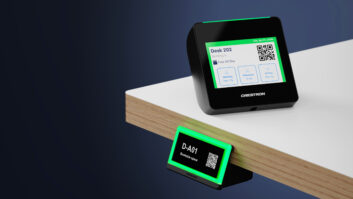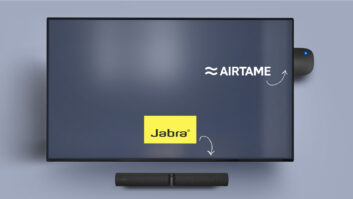 If half your team is in the office while the other is at home, corporate communications must cross the ‘Hybrid Chasm’. Is your corporate AV team prepared to build that bridge to improve productivity? When the pandemic hit, the primary concern was keeping your team together through conferencing software to avoid a complete shutdown of operations. As workers returned to offices, concerns shifted to providing safe environments that employees felt comfortable entering. But some your team has found ways to stay productive while at home. Now you need to look for ways to effectively bridge the physical and remote working worlds.
If half your team is in the office while the other is at home, corporate communications must cross the ‘Hybrid Chasm’. Is your corporate AV team prepared to build that bridge to improve productivity? When the pandemic hit, the primary concern was keeping your team together through conferencing software to avoid a complete shutdown of operations. As workers returned to offices, concerns shifted to providing safe environments that employees felt comfortable entering. But some your team has found ways to stay productive while at home. Now you need to look for ways to effectively bridge the physical and remote working worlds.
Hybrid working environments are now normal in the business world, and there is no reason to expect they won’t continue indefinitely. Zoom- and Teams-based meetings are the norm now that meeting participants are working across multiple home and corporate offices. Even short, face-to-face discussions in the ‘before times’ have turned to calls on a conferencing platform. And while working from home has brought new degrees of productivity, these conference platforms are just as quickly canceled out those gains.
CLEAR COMMS
It’s commonly understood how the lack of clear communications adds fatigue to employees in these endless, web-based calls and meetings, whether they are in the office or working from home. Tired employees also ‘shut down’ in these meetings or shift their attention to emails or other ‘multi-tasking’ distractions. What if I told you could raise your team’s engagement and productivity if you could reduce that fatigue and make it easier for people to communicate? Audio is the first place to start.
Do you ever miss the telephone? I do. The mic was pointed right at the source and the capture ratio over the room reflections was vastly superior to the run-of-the-mill audio we suffer through today. Inferior one- or two-mic element speakerphones, or worse the single element web camera mic, allow echoes and reflections to creep into the signal. The participant on the other side is working overtime to try to follow along or worse, tuning out. It’s bad for home office-based presenters, but it gets even worse in small conference rooms.
HEADSET SOLUTIONS
For the home office, headset mics are a good solution. They’re hands free and for the listener, it allows them to hear you, not the lousy acoustics in your home office. For huddle spaces and small conference rooms the most economical option is a multi-element speakerphone with on-board intelligent processing. Let it do the work of capturing and isolating the talker from steady-state room noise and echo so the listener doesn’t have to.
For larger spaces, an array of individual mics and a professional-grade DSP is critical. These devices bring greater clarity to the voice by filtering out the noise and echo captured through the acquisition process. These in-room audio improvements translate to improved intelligibility for the remote worker calling in over Zoom, Teams, and other conferencing software platforms. The V in AV is our next challenge to solve.
Remember your last live presentation? You knew your audience was keeping up with your witty talking points because you could see them. Likewise, they knew how passionate you were about the topic because they could see you.
The inability to see the other person effectively reduces the communication by half and raises frustration. If there’s video at all, many hybrid team members are using built-in laptop cameras. The worst ones are at keyboard level where fingers on the keyboard are like giant spiders and your nostrils are like black holes. This viewpoint also makes the participant on the other side subconsciously feel inferior as they are always looking up to you.
While in the office, that little webcam is woefully inadequate to cover the meeting space. Small form-factor, ePTZ (electronic Pan-Tilt-Zoom) cameras open the door for vastly improved video capture in both the home office and in the small conference room. Plugging these small cameras into laptops and positioning them on stands at your eye level or on your display can help participants feel engaged. For larger rooms, full-sized PTZ cameras can be automated through control systems to focus on each presenter. AV distribution gear with USB-C connectivity can be employed in these rooms to bring both the camera and speakerphone into the laptop driving the web-based meeting.
TECH ADVANCES
To effectively collaborate across the hybrid chasm, corporations need to improve video capturing tools. Technical AV advances for the modern hybrid work environment provide you with the opportunity to invest in high-quality tools for your team. Built-in laptop tools will simply not reproduce audio or visualise the collaborative spirit needed for clear communication and business productivity. Your hybrid workforce succeeds when audio technology contributes to voice intelligibility and when we integrate video tools that clearly capture everybody in the room.







